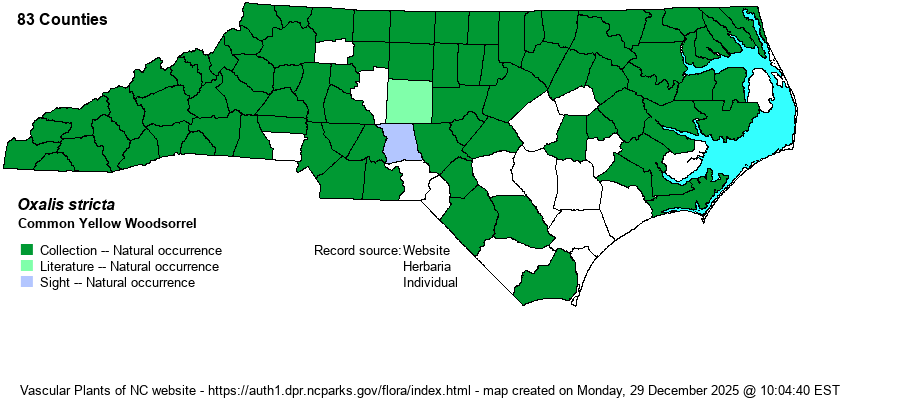| Author | L. | |
| Distribution | Essentially throughout, though of somewhat spotty distribution in the southern Coastal Plain.
This is a very widespread species of the eastern half of the continent, ranging south to northern FL and central TX.
| |
| Abundance | Common in the Mountains, Piedmont, and northern half of the Coastal Plain. Infrequent in the southern 40-50% of the Coastal Plain (including the Sandhills region). | |
| Habitat | This species has a great array of habitats, both natural and non-native. It is most common in disturbed ground of roadsides, edges, and fields. However, it does occur in some forest types, most often in bottomlands, wet thickets, and other damp ground, such as along streams and rivers. |
| Phenology | Blooms from May to October, and fruits shortly after flowering. | |
| Identification | The many species of yellow-flowered Oxalis are quite similar to each other, with small details separating most. All are small, branched, with numerous 3-parted, clover-like leaves on long petioles, and inflorescences of bright yellow, 5-petaled flowers. This species is somewhat taller or more sprawling than others, often 1-1.5 feet tall or long. The stems, highly branched, are mostly glabrous; the similar O. dillenii, which is the other native found in ruderal habitats, has strongly pubescent to hispid stems. Also, the 7-9 flowers are in a cyme (several times branched), as opposed to an umbel (stalks of the flowers coming off the same node) in O. dillenii and O. florida. The capsules are glabrous to only sparsely pubescent, whereas O. dillenii has strongly pubescent capsules. You might be able to identify this plant by its tall stature, if over 1 foot high, though you still want to look at stem hairiness and other structural characters to be certain. | |
| Taxonomic Comments | This has always been a good species, but many references, mainly older ones, included O. dillenii, O. florida, and perhaps other species within it. Thankfully we know much more about Oxalis taxonomy now than back in the middle decades of the 20th Century.
| |
| Other Common Name(s) | Yellow Woodsorrel (too generic), Upright Woodsorrel, Common Yellow Oxalis | |
| State Rank | S5 | |
| Global Rank | G5 | |
| State Status | | |
| US Status | | |
| USACE-agcp | UPL link |
| USACE-emp | FACU link |

